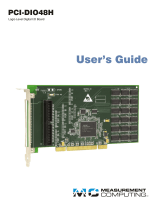Page is loading ...

Task MCC
Device Software
Acquire, Log and
View Data in Windows
without Programming
Most USB,
Bluetooth,
Ethernet
Install and run DAQami to configure the device and acquire data.
PCI/PCIe,
other USB
Install InstaCal and TracerDAQ (select the TracerDAQ checkbox during
installation).
Run InstaCal to configure the device, and then run TracerDAQ to acquire
data.
C, C++, C# NET, VB, or
VB .NET Programming
in Windows
USB,
Ethernet,
Bluetooth,
PCI/PCIe
Install InstaCal and the Universal Library (UL).
Run InstaCal to configure the device (recommended), or use the UL to
configure the device programmatically (advanced), and then use the UL to
acquire data programmatically.
Python Programming
in Windows
USB,
Ethernet,
Bluetooth
Install InstaCal and the Universal Library.
Install the Universal Library Python API for Windows from PyPI (https://
pypi.org/project/mcculw/). Refer to the Project Description for specific
requirements and installation instructions.
Run InstaCal to configure the device (recommended), or use the UL to
configure the device programmatically (advanced), and then use the UL to
acquire data programmatically.
C, C++, or Python
Programming in Linux USB
Install the Universal Library API for Linux from GitHub (https://github.
com/mccdaq/uldaq). Refer to the README for specific requirements and
installation instructions.
Use UL for Linux to configure the device and acquire data programmatically.
LabVIEW Programming
in Windows
USB,
Ethernet,
Bluetooth,
PCI/PCIe
Install InstaCal and ULx for NI LabVIEW (an existing LabVIEW 2010 or later
installation is required.)
Run InstaCal to configure the device, and then use ULx for NI LabVIEW to
acquire data.
Visit our website at www.mccdaq.com for information about each MCC DAQ software package.
© Measurement Computing Corporation. All rights reserved.
Measurement Computing Corporation • 10 Commerce Way • Norton, MA 02766
508-946-5100 • [email protected] • www.mccdaq.com
What do you want to do?
MCC DAQ Software Provides Your Data Acquisition Solution
Go to www.mccdaq.com/swdownload for the latest version of each software package.
DAQami • Universal Library (UL)* • ULx for NI LabVIEW • TracerDAQ
Quick Start
MCC DAQ Software
* Universal Library is a programming library available on Windows, Linux, and Android platforms.
UL for Windows also includes the InstaCal installation and test utility.

MCC DAQ Software
DAQami – Out-of-the-Box Data Acquisition Companion Software for Windows
• Easy-to-use drag and drop interface
• Acquire and generate analog, digital, and
counter/timer data
• Scalar, strip, block, and output displays
• Real-time output channel control
• Multiple device support
• No programming required
Universal Library – Data Acquisition Programming Library
Windows:
• Programming support for C, C++,
C# NET, VB, VB .NET, and Python
• Common function calls for most MCC
hardware
• Example programs
Linux
• Programming support for C, C++, and
Python
• Example programs
• Support for select MCC devices
(refer to www.mccdaq.com/Linux)
Android
• Develop apps for Android mobile devices
using JAVA
• Example programs and demo apps
• The same high-level functions as Universal
Library
• Support for select MCC devices
(refer to www.mccdaq.com/Android)

MCC DAQ Software
ULx for NI LabVIEW – Data Acquisition VI Library for LabVIEW
• Library, VIs, and example programs for
LabVIEW
• Comprehensive library of graphical
functions
TracerDAQ and TracerDAQ Pro – Out-of-the-Box Virtual Application Suite for Windows
• Virtual strip chart, oscilloscope, function
generator, and rate generator
• Acquire and generate analog and digital
data
• No programming required
InstaCal – Interactive Installation and Test Utility for Windows
• Configure MCC hardware
• Configuration is used by the UL,
ULx for NI LabVIEW, and TracerDAQ
• Test MCC hardware
• Calibrate supported hardware

Rev 4, Apr18
QS-MCCDAQ-web *326547D-01*
326547D-01
DAQami
Quick Start
DAQami Data Acquisition Companion Software is used to acquire and generate analog and digital data
from Measurement Computing USB, Ethernet, and Bluetooth hardware.
DAQami features an intuitive drag-and-drop interface where you can configure your device and acquire
data in minutes — no programming is required.
You can acquire, view, and log data in four steps.
Select a DAQ device
Add a Measurement Computing USB, Ethernet, or Bluetooth device to the acquisition.
If you don't have a physical device you can acquire data from the virtual DEMO-BOARD.
The DAQami Help file includes detailed information about how to modify configuration and acquisition
settings, customize each display, and export logged data. The DAQami Step-by-Step Guide shows you how
to set up the acquisition.
Download and install DAQami from www.mccdaq.com/DAQami.
Configure device, channel, and acquisition options
Select the channels from which to acquire data, and configure the acquisition. Options may include the
channel mode, measurement type, scale factors, DIO direction, counter mode, sample rate, trigger type,
and so on. The available options are specific to the selected device.
Add displays and channels
Drag your channels onto any combination of strip, block, and scalar displays. The output display provides
real-time controls you can manipulate during an acquisition.
Acquire and log data
Acquired data is plotted on the displays. You can run the acquisition and preview the data without
logging, or run the acquisition and log the data to disk. Data is acquired from each activated channel,
even if it is not added to a display.
You can show the values of specific data points, and review data as it is acquired.
/
